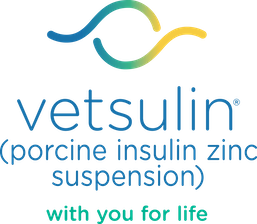

Treatment Monitoring
Learn More About Dosing & Administration
Insulin Treatment Monitoring in Dogs with Diabetes
Monitoring and Adjusting Dose
Dogs with diabetes should be re-evaluated 1 week after starting Vetsulin® (porcine insulin zinc suspension).
- At the time of re-evaluation, it is important to obtain and record the owner’s overall impression regarding their dog’s clinical signs.
- It is essential to weigh the dog at each follow up visit. Changes in body weight will reflect response to treatment. In addition, significant changes in body weight may influence dosage decisions.
- Sample blood glucose to determine if regulation has been achieved. Regulation should be assessed using chosen monitoring protocol.
- Dose adjustments are based on the monitoring test results and reported clinical signs and should generally be performed in increments of 10%. Dose adjustment should be made no more frequently than every 5 to 7 days, and only if indicated by clinical signs AND glucose measurements.
- If the dog’s clinical signs persist and the blood glucose curve indicates a duration of activity of less than 14 to 18 hours, then twice-daily injections at 12-hour intervals may be indicated. When switching from once-daily to twice-daily therapy, the Vetsulin dose needs to be decreased by 25% (not 10%). For example, if a dog receives 20 IU of Vetsulin once daily, the new dose would be 15 IU twice daily.
- Once good regulation is established, dogs should be rechecked every 2 to 4 months.
When clinical signs disappear and the owner is happy with the situation, the main goals of therapy have been achieved.
Is An Adjustment Needed?
Insulin dose requirements may change suddenly even after a long period of stability because of any of the following concurrent factors:
- Inflammation or infection (eg, pyoderma, cystitis)
- Altered exercise regimen
- Weight loss or gain
- Additional medications
- Other illnesses or diseases (eg, renal failure, heart failure, Cushing’s disease, hypothyroidism)
- Changes in progesterone concentrations caused by diestrus
- Corticosteroid or progestogen administration
Veterinarians should reevaluate dogs with diabetes at appropriate intervals and adjust the dose based on clinical signs, urinalysis results, and glucose curve results.
Dose adjustments in the dog should be performed in increments of 10%. Following adjustment, wait to reevaluate until the new dose has been given for at least 5 to 7 days, unless evidence of hypoglycemia appears.
Aim to maintain blood glucose concentrations below the renal threshold for a substantial part of the day. This will result in the disappearance of most of the dog’s clinical signs, which is the main goal of therapy.
Help Your Practice Manage Diabetes Mellitus
View and download resources and tools that will assist your hospital, inform your team, and help with clients.

Blood Glucose Curve Generator
Create a blood glucose curve to monitor and evaluate diabetes treatments.

Client Discharge Form
Create a customized, printable form for clients about their new diagnosis.

Diabetes Resources
Access online tools and more to support staff and pet parents.
No items to show.
Learn More About Dosing & Administration
Important Safety Information:
Vetsulin® should not be used in dogs known to have a systemic allergy to pork or pork products. Vetsulin is contraindicated during periods of hypoglycemia. Keep out of reach of children. As with all insulin products, careful patient monitoring for hypoglycemia and hyperglycemia is essential to attain and maintain adequate glycemic control and prevent associated complications. Overdosage can result in profound hypoglycemia and death. The safety and effectiveness of Vetsulin in puppies, breeding, pregnant, and lactating dogs has not been evaluated. See package insert for full information regarding contraindications, warnings, and precautions.
References:
1. Martin GJ, Rand JS. Pharmacology of a 40 IU/ml porcine lente insulin preparation in diabetic cats: findings during the first week and after 5 or 9 weeks of therapy. J Feline Med Surg. 2001;3(1):23–30. 2. Vetsulin® (porcine insulin zinc suspension) [Freedom of Information Summary]. Millsboro, DE: Intervet Inc.; 2008. 3. Data on file, Merck Animal Health. 4. Graham PA, Nash AS, McKellar QA. Pharmacokinetics of porcine insulin zinc suspension in diabetic dogs. J Small Anim Pract. 1997;38(10):434–438. 5. Martin GJ, Rand JS. Pharmacokinetic and Pharmacodynamic Study of Caninsulin in Cats with Diabetes Mellitus. 2000: Internal Study Report. 6. Feldman EC, Nelson RW. Canine and Feline Endocrinology and Reproduction. 3rd ed. St. Louis, MO: Saunders; 2004:539–579. 7. Tennant B, ed. BSAVA Small Animal Formulary. 4th ed. Gloucestershire, UK: British Small Animal Veterinary Association; 2002. 8. Feldman EC, Nelson RW. Canine and Feline Endocrinology and Reproduction. 3rd ed. St. Louis, MO: Saunders; 2004:486–538. 9. Reusch C. Feline diabetes mellitus. In: Ettinger SJ, Feldman EC, eds. Textbook of Veterinary Internal Medicine. 7th ed. St. Louis, MO: Saunders; 2010:1796–1816. 10. Nelson RW. Canine diabetes mellitus. In: Ettinger SJ, Feldman EC, eds. Textbook of Veterinary Internal Medicine. 7th ed. St. Louis, MO: Saunders; 2010:1782–1796. 11. Burgaud S, Riant S, Piau N. Comparative laboratory evaluation of dose delivery using a veterinary insulin pen. In: Proceedings of the WSAVA/FECAVA/BSAVA congress; 12–15 April 2012; Birmingham, UK. Abstract 121. 12. Burgaud S, Guillot R, Harnois-Milon G. Clinical evaluation of a veterinary insulin pen in diabetic dogs. In: Proceedings of the WSAVA/ FECAVA/BSAVA congress; 12–15 April 2012; Birmingham, UK. Abstract 122. 13. Burgaud S, Guillot R, Harnois-Milon G. Clinical evaluation of a veterinary insulin pen in diabetic cats. In: Proceedings of the WSAVA/FECAVA/BSAVA congress; 12–15 April 2012; Birmingham, UK. Abstract 45. 14. Davison LJ, Walding B, Herrtage ME, Catchpole B. Anti-insulin antibodies in diabetic dogs before and after treatment with different insulin preparations. J Vet Intern Med. 2008;22:1317-1325. 15. Banfield State of Pet Health 2016 Report. p 12-13.
